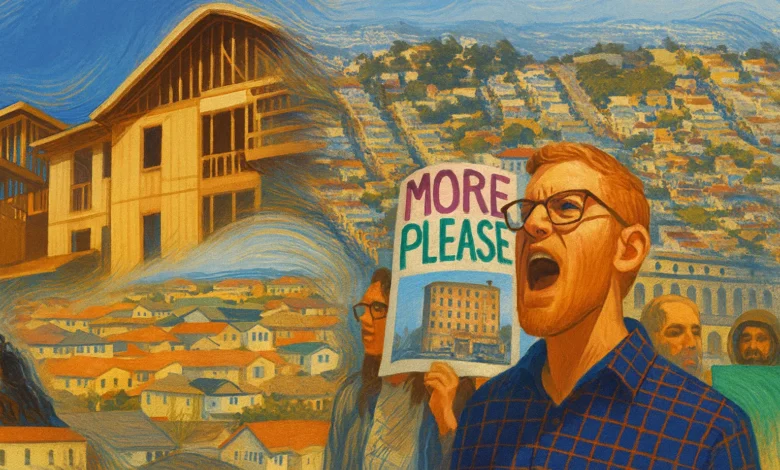Sunday Commentary: Why the Politics of Housing Look Different in 2025

- “The YIMBYs have changed the narrative in this state on housing.” – Ben Christopher
California’s housing debate has undergone a remarkable transformation over the past decade. Once dominated by stalemates, environmental reviews, and local control battles, the conversation has shifted toward an acceptance that the state must build far more housing.
The YIMBYs have been at the forefront of this shift. With a landmark bill now sitting on Governor Gavin Newsom’s desk, the movement appears closer than ever to reshaping the rules of development in California.
As longtime readers understand, I have a lot of questions as to whether this will ultimately produce the housing that we need – but there can be no doubt that the YIMBYs have changed the narrative in this state on housing.
The proposal, SB 79, is the latest effort by Senator Scott Wiener of San Francisco to upend decades of restrictive zoning. The bill would allow taller, denser buildings near major bus stops and transit lines, overriding local rules that prohibit multifamily housing in large swaths of urban California.
It is, in many ways, the culmination of a fight Wiener has been waging since 2018, when he first introduced a version of this idea.
On KQED’s Political Breakdown, Scott Shafer and Marisa Lagos laid bare just how much the politics of housing have shifted.
Their conversation with CalMatters reporter Ben Christopher and California YIMBY CEO Brian Hanlon was less about the technical details of Senate Bill 79 and more about the political moment itself—the realization that a movement once dismissed as naïve has forced its way into the center of power in Sacramento.
What was once a fringe fight over zoning maps has become a defining battle over the future of California’s cities, neighborhoods, and even its identity.
Ben Christopher, a reporter for CalMatters who has tracked the debate from its beginning, explained that the bill has always been controversial.
“It has been quite controversial and it has been controversial since 2018 when the first version of this bill was first introduced,” he said.
He described how the original bills failed quickly, often dying in committee, but persistence and the growing YIMBY coalition kept the issue alive.
The political climate has changed. In the late 2010s, it was not widely accepted that California’s housing affordability crisis stemmed from a shortage of homes.
Today, Christopher said, “for the most part in the Legislature” lawmakers agree that supply must increase and that zoning restrictions have constrained the state’s ability to build. What was once seen as a radical idea is now part of mainstream legislative consensus.
Still, that consensus is not without fissures. Housing politics cut across partisan lines in ways few other issues do. Christopher noted that conservative Republicans often supported Wiener’s proposals out of allegiance to free-market principles, while progressive Democrats sometimes opposed them as giveaways to developers.
Labor groups often resisted changes that would weaken regulations they used for leverage.
Meanwhile, neighborhood associations and city governments fought against any erosion of local planning power.
To move SB 79 forward, lawmakers accepted more than a dozen amendments.
The bill now applies primarily to eight large counties, including Los Angeles, San Diego, San Francisco, Sacramento, and Alameda. It requires replacement of rent-controlled units to address concerns about displacement, and it delays implementation in low-income areas until 2032. With each amendment, new blocs of opposition dropped away.
Equity advocates secured protections for affordable housing, unions won concessions, and eventually, Christopher explained, the only opposition left came from neighborhood groups and cities resistant to density.
Even within organized labor, divisions emerged. The carpenters aligned with YIMBY priorities, while the building trades historically pushed back. This year, however, the trades softened their stance. Christopher called this “one of the undertold stories about how this bill came to be,” noting that the trades took a much more moderate position, perhaps recognizing the political tide was shifting.
Yet not everyone has embraced the change.
Los Angeles Mayor Karen Bass urged the governor to veto the bill, reflecting frustration among city leaders who feel they have already been through arduous rezoning processes required by the state’s housing element law. In Los Angeles, officials sought to protect single-family neighborhoods during that process, only to see the state threaten to impose denser zoning anyway.
By contrast, San Francisco Mayor Daniel Lurie has embraced additional upzoning, rolling out a plan that in some areas would go beyond what SB 79 requires.
The divergent approaches highlight a larger theme: local politics and leadership still shape how state housing mandates are received. Los Angeles has been cautious, balancing neighborhood opposition with mandates, while San Francisco has leaned into upzoning as a way to preempt state intervention.
For Bass, the politics are especially delicate as she faces pressure from neighborhoods wary of density. For Lurie, still early in his tenure, the honeymoon period allows him more space to push bold reforms.
If SB 79 is signed, implementation battles will almost certainly follow.
Christopher predicted fights in city councils and the courts as local governments look for ways to retain control. Some mayors and council members will comply grudgingly, while others may attempt to slow-walk changes. Lawsuits are likely, adding another layer of conflict to a debate that has never been confined to Sacramento.
For YIMBY leaders, the moment is both vindication and challenge.
Brian Hanlon, CEO of California YIMBY, recalled the origins of the movement in 2017, when he and his colleagues realized that California’s Housing Accountability Act was too weak to compel cities to follow state law. He described how he wrote a new draft of the law himself, despite lacking money or political connections, and took it to Sacramento. “I had this insane realization that, oh wow, little d representative democracy works and you can be an ordinary citizen and have this huge voice, even though I had no money at the time, no real connections,” he said.
Hanlon and his co-founders envisioned a broad organization that would combine lobbying, policy development, grassroots organizing, media campaigns, and electoral work. He pitched the idea to early supporters from the tech sector, who helped launch California YIMBY. “That was really the origin of California YIMBY,” he said. “The first bill I pitched them on is the bill that ended up becoming SB 79, which recently passed a state legislature.”
Over time, the group has helped shift the conversation about environmental review as well. Hanlon recalled drafting a 2017 plan that called for exempting infill housing from CEQA review but dismissed it as impossible.
Today, CEQA reforms are part of mainstream debate. He argued that it makes no sense to subject climate-friendly infill housing to the same environmental hurdles as a new oil refinery. He also framed the change as generational: younger environmentalists see climate change and affordability as intertwined, while older advocates often focused more narrowly on preservation.
Despite progress, Hanlon acknowledged that high costs and fees remain daunting. Permitting processes, utility hookups, and local requirements can stall projects even after zoning barriers are lifted.
“In terms of bills that have passed when they’re fully implemented, I do think we have made a massive amount of progress except in one area: fees and expensive requirements,” he said.
The politics of local control remain a sticking point. SB 79 allows cities to design their own compliance plans, and some will be functionally exempt until the 2030s if they have already planned substantial upzoning.
Hanlon said he understands the fairness of local arguments, even as he pushes for statewide mandates.
Perhaps the most revealing part of his comments concerned how to talk to skeptics. He said most people are not deeply engaged in zoning fights and are focused on everyday concerns.
“Most people don’t care all that much about the issue I’m working on. Most people have never heard of it,” he said.
The opposition that does exist is often loud but unrepresentative.
Polling shows most San Franciscans support building more housing along transit corridors, but public hearings can be dominated by small groups of opponents.
Hanlon said he tries to connect the debate to shared values. “Do you care about climate? Do you care about your kids being able to afford here? Do you want to be able to see your grandkids more than once a year?” he asked. By framing the issue in terms of family, climate, and community, he believes skeptics can accept change even if they dislike specific projects.
That kind of argument may be why YIMBYs are increasingly winning legislative battles. The framing has moved from abstract zoning rules to tangible consequences: whether children can afford to live near their parents, whether workers can live near jobs, whether California will meet its climate goals.
The next chapter will test whether laws like SB 79 translate into actual housing. Newsom is expected to sign the bill, but compliance will vary widely across cities. Legal battles will likely slow implementation, and entrenched neighborhood opposition will not vanish overnight. But the political debate has shifted. What was once dismissed as fringe policy is now state law.
California’s housing crisis remains severe, and no single bill will solve it. But the success of SB 79, and the YIMBY movement behind it, reflects a profound change in the way the state confronts its housing shortage. If YIMBYs have not yet won, they are clearly no longer on the outside looking in.
Follow the Vanguard on Social Media – X, Instagram and Facebook. Subscribe the Vanguard News letters. To make a tax-deductible donation, please visit davisvanguard.org/donate or give directly through ActBlue. Your support will ensure that the vital work of the Vanguard continues.
Categories:
Breaking News Housing State of California
Tags:
Ben Christopher Brian Hanlon california housing California Politics California YIMBY Gavin Newsom Governor Gavin Newsom Los Angeles Mayor Karen Bass San Francisco Mayor Daniel Lurie SB 79 Scott Wiener Senator Scott Wiener Yimby YIMBYs
Credit: Source link






